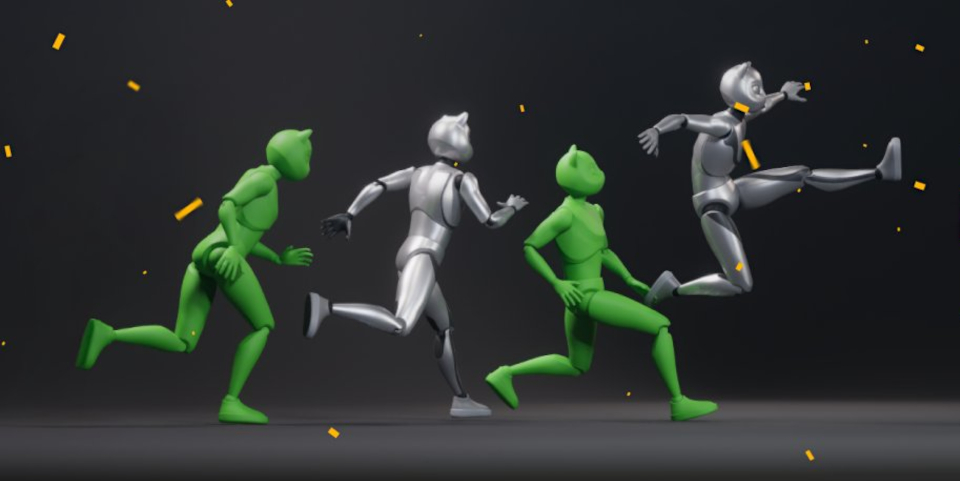Nekki releases Cascadeur 2025.3

Nekki has released Cascadeur 2025.3, the new version of the AI-assisted animation app.
The update integrates Filament, Google’s physically based render engine, as the viewport renderer on Windows, and adds experimental support for rigging and posing quadrupeds.
Create animations based on real-world physics, aided by AI-based tools
Launched in 2019, Cascadeur is intended as an artist-friendly alternative to conventional animation software for game development, motion graphics or visual effects work.
Although it has standard tools for rigging, posing and animating characters, its unique selling point is a set of AI-assisted, semi-automated toolsets.
Key poses can be quickly established for a character via the AutoPosing system, which lets users reposition a small number of joints, and have Cascadeur take care of the rest of the body.
For a jumping character, the software can then calculate a physically correct trajectory between the key poses.
For other types of motion, a separate AI-trained system, AutoPhysics, converts an existing keyframe animation into a physically accurate version of itself.
Once generated, animations may be exported the FBX, Collada or USD format for use in other DCC applications, or game engines like Unity and Unreal Engine.
Cascadeur 2025.3: new, higher-quality viewport renderer (alpha, Windows only)
Cascadeur 2025.3 improves the visual quality of viewport previews, since Nekki has integrated Filament, Google’s open-source physically based renderer, as its new viewport renderer.
Unlike the previous viewport render engine, it supports HDRI environment lighting, and supports complete PBR materials rather than simple textures.
It’s still a highly experimental feature, and is currently only available for Windows users, via a separate alpha build.
Nekki says that it aims to make Filament available in the main build in future releases, on all platforms: Google provides source code for Filament for Android, iOS, Linux and macOS.

Rig and pose quadrupeds as well as bipeds (alpha)
Another major change in Cascadeur 2025.3 is the option to rig quadrupeds, as well as bipeds.
The Quick Rigging tool gets a new Quadruped tab for rigging four-legged creatures, shown in the image above.
Again, it’s an alpha feature, and is currently oriented to cats and dogs: Nekki says that you’ll “probably have a hard time” rigging other types of quadruped, including horses.
For users with Pro subscriptions, it is also now possible to use AutoPosing on quadrupeds.
AI inbetweening reworked from a separate tool to a type of interpolation
In addition, the AI-powered Inbetweening system introduced in Cascadeur 2025.1 has been reworked to make it a type of interpolation rather than a separate tool.
That makes it possible to apply AI inbetweening only to specific Animation Tracks: for example, to use it only for specific body parts, rather than for an entire character.
In addition, making changes to an animation – for example, adding additional keyframes – no longer requires inbetweening to be reset manually.
Updates to the Quick Rigging tool and Ragdoll system
Other changes include support for Twist and Untwist bones in the Quick Rigging tool, and for Angle Constraints in the Ragdoll system.
There are also a number of smaller feature and workflow updates, listed in the release notes.
Price, system requirements and release date
Cascadeur 2025.3 is compatible with Windows 10+, Ubuntu 20.04+ Linux and macOS 13.3+.
For users earning under $100,000/year, Indie subscriptions cost $19/month or $96/year. Pro subscriptions cost $49/month or $396/year and add advanced features.
Both are rent-to-own plans, with users qualifying for a perpetual license after one year.
There is also a free edition, which is not licensed for commercial use, and saves animation in its own .casc file format, making it impossible to use in other DCC apps.
Read a full list of new features in Cascadeur 2025.3 in the release notes
Have your say on this story by following CG Channel on Facebook, Instagram and X (formerly Twitter). As well as being able to comment on stories, followers of our social media accounts can see videos we don’t post on the site itself, including making-ofs for the latest VFX movies, animations, games cinematics and motion graphics projects.
